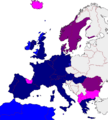Article (grammar) facts for kids
An article is a special kind of word that comes before a noun. Think of nouns as names for people, places, things, or ideas. Articles help us understand if we're talking about a specific noun or a general one.
There are two main types of articles:
- Definite articles
- Indefinite articles
In English, we have just one definite article: "the". We use "the" when we're talking about something specific that everyone knows about or that we've already mentioned.
We have two indefinite articles: "a" and "an". We use "a" when the next word starts with a consonant sound. For example, we say "a horse" or "a child". We use "an" when the next word starts with a vowel sound. For instance, we say "an orange" or "an elephant". It's important to remember it's about the sound, not just the letter! That's why we say "a university" (because 'u' sounds like 'yoo', a consonant sound) but "an hour" (because 'h' is silent, and 'o' is a vowel sound).
Contents
Articles Around the World
Many languages have articles, but they can be different from English.
Articles in Other Languages
Some languages have more than one word for "the". This often depends on the gender of the noun. Nouns can be masculine, feminine, or sometimes neuter.
For example, in French:
- "le" is used for masculine nouns (like "le jardin" meaning "the garden").
- "la" is used for feminine nouns (like "la table" meaning "the table").
- When nouns are plural (more than one), "the" becomes "les".
French also has indefinite articles: "un" for masculine nouns and "une" for feminine nouns.
German and Ancient Greek also have masculine, feminine, and neuter nouns, and their articles change to match. However, in Dutch, the word for "the" is usually "de" for both masculine and feminine nouns.
The Māori language, spoken in New Zealand, uses different words for "the" depending on whether you're talking about one thing or many things.
Languages Without Articles
It might surprise you, but many languages don't use articles at all! Some examples include Russian, Hindi, Japanese, and Chinese.
For people who speak these languages, learning English can be tricky because they have to learn when to use "a," "an," and "the." Even without articles, these languages have other ways to show if something is specific or general.
When to Use Articles
Knowing when to use "a," "an," or "the" can be simple once you get the hang of it.
Using "The" for Specific Things
We use "the" when we're talking about something specific that you or the person you're talking to already knows about.
- Imagine: "The tired woman was looking for her cat. Suddenly she saw the cat up a tree."
* Here, we already know which cat she's looking for, so we use "the cat." * The tree is a new idea, so we use "a tree."
- Now imagine: "The tired woman was walking along when she suddenly saw a cat up a tree."
* In this case, she wasn't thinking about cats before. It's a new cat she just saw, so we use "a cat." The tree is also new, so "a tree."
When No Article is Needed
Sometimes, we don't need an article at all. This often happens when we're talking about things in a general way.
- "The dogs do not bite" means specific dogs that you are thinking about.
- "Barking dogs do not bite" means barking dogs in general, any barking dogs.
Images for kids
-
Articles in languages in and around Europe indefinite and definite articles only definite articles indefinite and suffixed definite articles only suffixed definite articles no articles Note that although the Saami languages spoken in northern parts of Norway and Sweden lack articles, Norwegian and Swedish are the majority languages in this area. Although the Irish, Scottish Gaelic and Welsh languages lack indefinite articles they too are minority languages in Ireland, Scotland and southern Wales, respectively, with English being the main spoken language.
See also
 In Spanish: Artículo (gramática) para niños
In Spanish: Artículo (gramática) para niños


